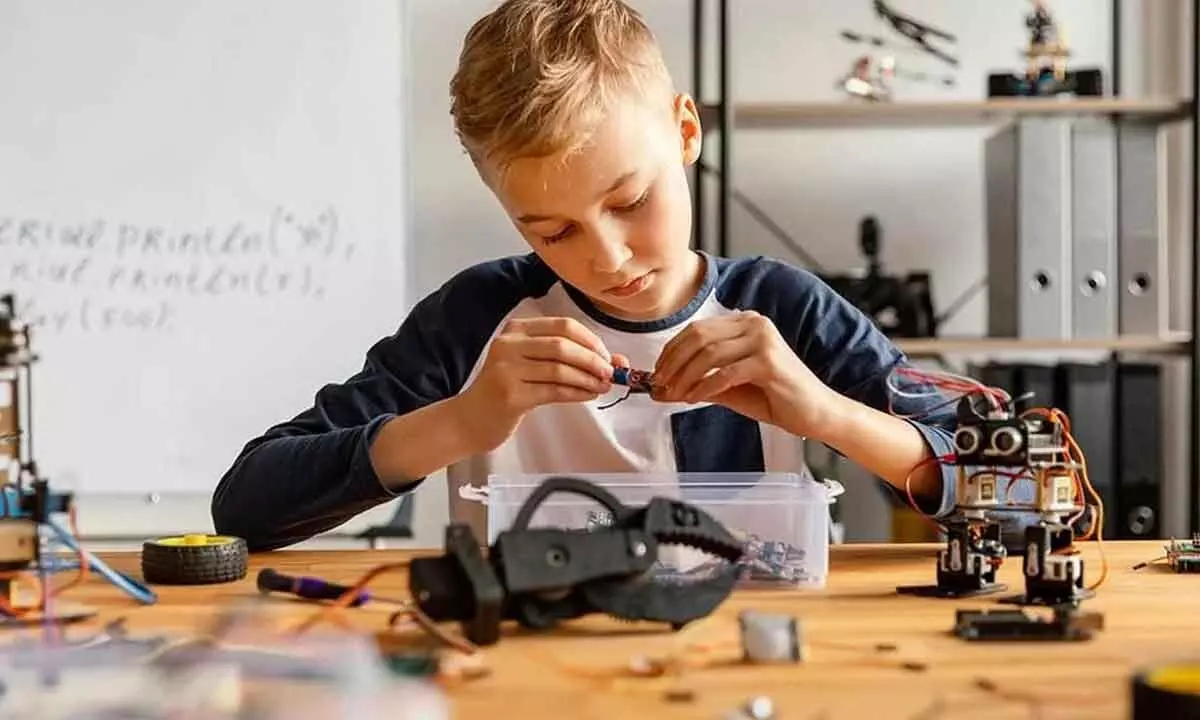Live
- Krishna Janmabhoomi-Shahi Eidgah dispute: Consolidation of suit should benefit both sides, says SC
- Champion of stronger relations with India, Chandra Arya runs for Canadian PM's race
- Thai Chicken Sliders
- Plant-based chicken seekh kebab kathi roll
- Chicken Keema Kebab
- Tragic Bus Accident in Suryapet District: Four Dead, 17 Injured
- Madhur Sharma launches new EP ‘Reversion’; announces nationwide tour
- New Telugu Movies and Web Series Streaming This Week on OTT Platforms
- Somy Ali announces plans to adopt baby girl from India
- ‘What If...?’ Season 3 review
Just In
The role of robotics in STEM education


Robotics promotes the idea of application in general. Students are no longer restricted to mere theorems and theoretical principles but are also aware of their practicality. This instils an approach of practical implementation and helps them in their job later. Students can verify the practical application and this has given the best results in industries such as space exploration, healthcare and manufacturing. Furthermore, learning with machines and educational robots encourages students to be highly creative and innovative. It allows the student with the freedom to think out of the box and experiment different ideas. This approach further fosters imaginative thinking and allows the students to explore varied solutions to a given problem
In the past few decades, robotics has experienced great advancement, because of the widespread research and testing. There has been growth in the practical application, which has also benefited several educational streams. In particular, the Science, Technology, Engineering and Mathematics (STEM) have greatly benefited. This has not only introduced the students of these fields to cutting-edge technology but has also ignited their passion for solving problems and gaining hands-on experience. There are many ways in which robotics is shaping STEM education and some of them are explained below.
STEM education involves logic, scientific findings, and the integration of several laws of physics and mathematics. There is a very low to no margin of error because the application is derived from age-old scientific laws and mathematical theorems that have a rigid frame. Robotics facilitates the integration of technology, science, mathematics, and engineering, enhancing the learning and instructional process.In recent years, the application of robotics in STEM education has enhanced the learning process, as students now receive assistance from machines. This has encouraged computational thinking among the students further amplifying the learning process. Unlike other learning tools, educational robots are designed as vehicles, animals or humans of different shapes and sizes. This is done to promote interaction between students and the machine and enhance the whole learning experience. Besides interaction, students can verify the application of scientific laws immediately and get the results in an instant.
Easier understanding of STEM laws
STEM laws and theorems are complex and do not allow any variation in the practical application. Instead of learning passively from an instructor, robotics allows students to interact in real time with a machine and understand the practical application quickly. This aids in comprehending complex STEM principles and enhances practical application. It positively influences the overall learning attitude of students, as numerous researchers have found that learning with educational robotics and gamification is highly effective. Students learning with robotics have also shown a higher level of motivation as compared to those learning through traditional methods. Students develop a cognitive ability to solve problems, which is the very basis of STEM subjects.
Bridging the gap between theory and practice
In traditional methods, normally there are separate theory and practical sessions. In this method, there is a ‘lag’ in the application of the learned principles. Robotics help in bridging the gap that lies between theoretical knowledge and practical application. Students can apply their learning in real-time and witness tangible results through immediate practical exercises in design, building, and programming.
Promotes collaboration and teamwork
Almost every project that involves the use of robotics is collaborative. This helps the students to instil the habit of working in teams and gain collective learning. This not only promotes cooperation and teamwork but also helps students understand effective communication. This learning is not only restricted to the subject at hand but is helpful in all major aspects of life. Besides, if encountering a problem with the application of robotics and machine principles, if one direction does not give results, the students can collectively work on applying a different approach.
Promotes real-world application, creativity and innovation
Robotics promotes the idea of application in general. Students are no longer restricted to mere theorems and theoretical principles but are also aware of their practicality. This instils an approach of practical implementation and helps them in their job later. Students can verify the practical application and this has given the best results in industries such as space exploration, healthcare and manufacturing. Furthermore, learning with machines and educational robots encourages students to be highly creative and innovative. It allows the student with the freedom to think out of the box and experiment different ideas. This approach further fosters imaginative thinking and allows the students to explore varied solutions to a given problem.
Robotics has not only helped make the learning process easier but has also encouraged the students to learn with a different approach. This approach of being creative is very important to effectively understand the laws and principles and Science, Technology, Engineering and Mathematics (STEM), as these trades are home to future innovators, healthcare researchers and technologists.
(The author is Chancellor, KL Deemed to be University, Andhra pradesh)

© 2025 Hyderabad Media House Limited/The Hans India. All rights reserved. Powered by hocalwire.com






